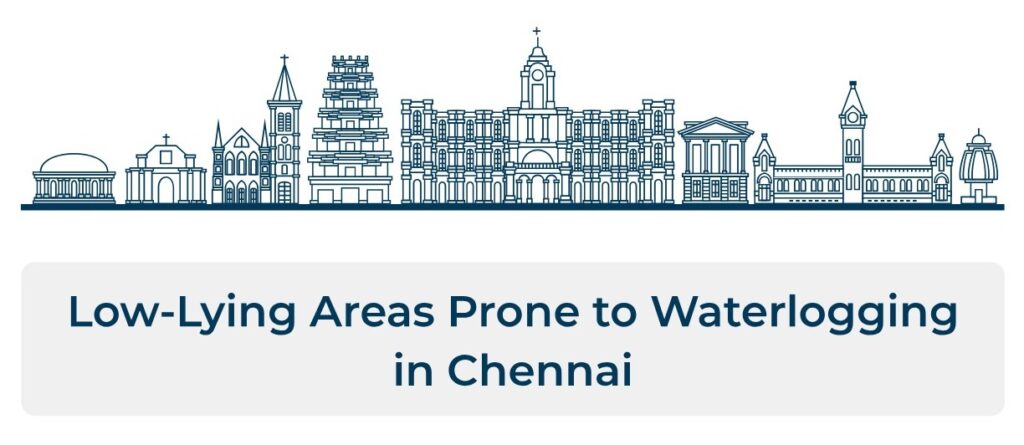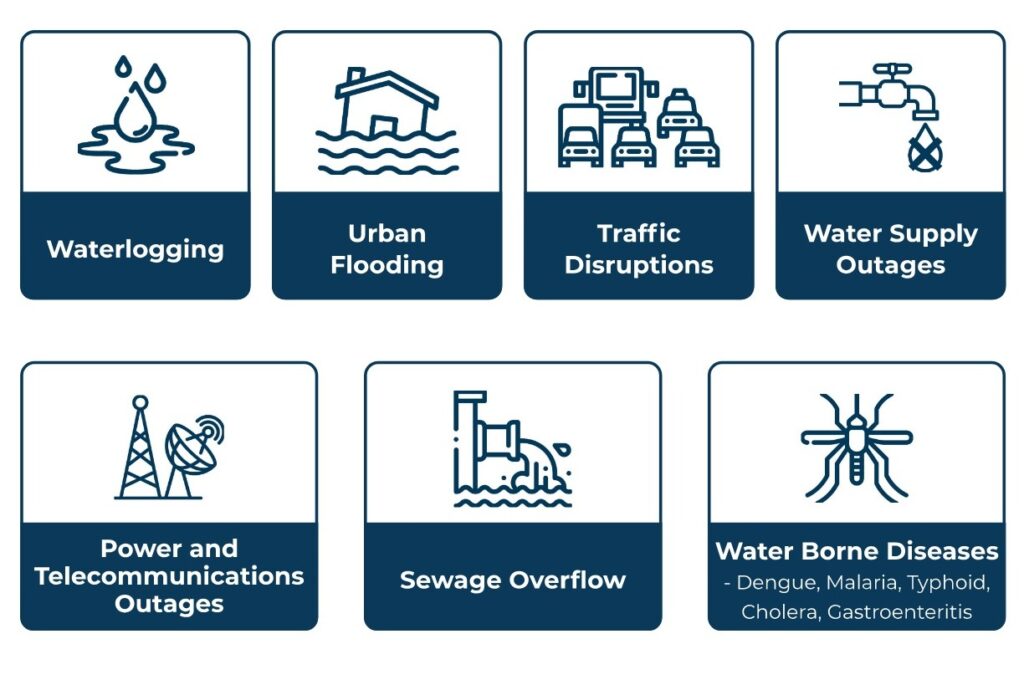
The primary monsoon season in Chennai is between October and December, due to the northeast monsoon season. Chennai receives moderate to heavy rainfall, amounting to nearly 48 percent of the annual rainfall during this period, making the city susceptible to localised waterlogging and urban flooding.
Chennai is prone to urban flooding during the northeast monsoon season. Infrastructural damage, power outages for several days, widespread travel disruptions are some of the prominent issues faced during monsoon. Additionally, heavy rainfall and flooding often prompt authorities to either issue stay-at-home or evacuation orders.

Medium Impact Area
Natural Disasters – Recently Recorded
Chennai is located only 6.7 metres above the sea level; hence, it has several low-lying areas across the city making it prone to flooding. The high-pressure area over Central Asia and the low-pressure area over Bay of Bengal that develops during the northeast monsoon season, makes Chennai susceptible to cyclonic movements.
In December 2022, Cyclone Mandous impacted Chennai with heavy rainfall and strong winds. Besides infrastructural damage and traffic disruptions, over 700 people were evacuated, and more than 30 relief camps were set up.
In May 2023, Cyclone Mocha was expected to impact Chennai but eventually moved towards Bangladesh and Myanmar. Localized rainfall and minor thunderstorms were reported in Chennai. However, no significant damage to life and property were noted.
Common Disruptions

Precautions by the Government:
- Greater Chennai Corporation (Chennai Municipal Corporation) has been working towards building efficient stormwater drainage systems.
- The state electricity board prepares itself every year ahead of the northeast monsoon season to adequately deal with and respond to power outages.
- In the event of heavy rainfall or severe flooding, the government is well prepared to set up relief camps and send evacuation teams.
- Police are deployed in larger numbers for maintenance of traffic flow. Often diversions and temporary blockades are issued for traffic management.
Reccomendations
For Organizations
- Advised to undertake flexible working arrangement and allow remote work on days with inclement weather conditions.
- Conduct regular maintenance of equipment, machinery, and facilities to ensure they are in optimal condition to withstand any damage that may occur due to severe flooding.
- Advised to inspect and reinforce the infrastructure of your business remises to withstand heavy rainfall and strong winds.
- Undertake dampness check for water and electrical leakages.
- Prepare for adequate backups to minimise the impact of power outages.
- Organisations are advised to conduct evacuation drills and spread awareness among employees to remain prepared for emergencies.
- Organisations are encouraged to install flood barriers to prevent water from entering the premises.
For Individuals
- Advised to consider extra travel time as even low intensity rainfall may lead to severe congestion and consequent delays.
- It is advised to prepare for flood in adherence to the guidelines issued by the Natural Disaster Management Authority of India.
- Keep the surrounding clean. Unclog drains and trim the plants (if any) within the residential complex to avoid any kind of blockades.
- Be cautious during thunderstorms: Seek shelter indoors and remain vigilant of alerts and warnings issued by authorities.
- Stay away from tall structures, trees, and open areas.
- Unplug electronic devices to prevent damage from power surges during electrical storms.
- Use mosquito repellents and wear protective clothing.
- Taxi (online and offline) and delivery services tend to charge surge fees during rainfall. Advised to take the same into account and plan accordingly.
- Avoid consumption of unfiltered water or street food.
- MitKat advises to keep a fresh set of clothes in the office, keep mobile devices charged for emergency and keep important documents in waterproof bags.
- In case driving in low-lying areas, avoid hard accelerations and brakes; maintain a steady momentum and do not restart engine while the vehicle is stalled in water. For further safe driving guidelines, refer to MitKat’s Special Advisory on Safety Measures for Vehicles During Heavy Rainfall.
Emergency Contacts and Source Links –
- Weather Updates – Chennai District-Wise Forecast, Chennai District-wise Nowcast
- Traffic Updates – Chennai Traffic Department
- Power Supply – Chennai Power Supply
- Greater Chennai Corporation (GMC) – 1913 (Toll Free) or 22310989 / 22321090/ 223211085
- GMC Control Room – 044-25619206 / 044-25303511



